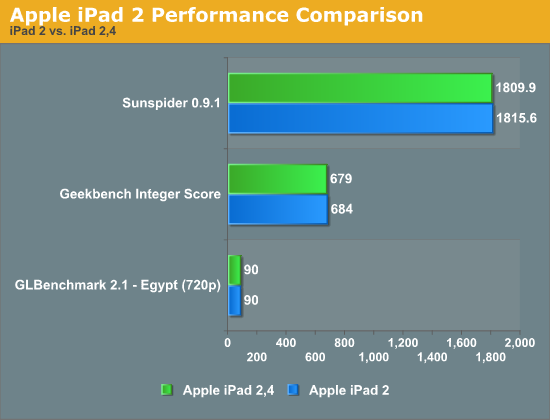The iPad 2,4 Review: 32nm Brings Better Battery Life
by Anand Lal Shimpi on May 4, 2012 12:50 AM ESTDecreased Power Consumption
We obviously know the impact of the new SoC on battery life but here's a look at just how much less power the new platform draws in various conditions. Note that for whatever reason the iPad's power consumption when sitting at the home screen is actually higher than when running our 720p High Profile video playback test. The results were consistent as I tested multiple times across multiple iPads. I have a few thoughts as to what could be happening here:
| Tablet Power Consumption (including Display) | ||||||
| iPad 2,4 | iPad 2 | iPad (3rd generation) | ||||
| Homescreen | 2.7 W | 2.9 W | 6.1 W | |||
| Sunspider | 3.4 W | 4.3 W | 7.6 W | |||
| Moonbat (20 x 4) | 3.9 W | 5.0 W | 8.3 W | |||
| GLBench Egypt (native res) | 3.8 W | 4.5 W | 9.6 W | |||
| GLBench Egypt (offscreen 720p) | 4.1 W | 4.8 W | 10.0 W | |||
| Infinity Blade 2 | 4.3 W | 5.1 W | 10.3 W | |||
| Riptide GP | 3.9 W | 4.7 W | 10.2 W | |||
| Video Playback (720p HP) | 2.2 W | 2.4 W | 4.9 W | |||
Under heavy CPU load (multithreaded Sunspider) we see a 28% increase in power consumption from the 45nm iPad 2,1 compared to the newer 2,4. Keep in mind that we're looking at peak power consumption here, which helps explain the smaller gap on the GPU side than what we saw in our battery life tests. What this data does show however is that the power efficiency improvements can be just as significant for CPU bound workloads, it's simply harder to find workloads that are CPU bound for long periods of time.
Looking at the 3rd generation iPad data reminds us of just how power hungry that platform is. It truly is Apple's performance halo, and it's the perfect target for a 32nm SoC in the future.
The iPad 2 battery life comparison numbers were generated on a lightly used iPad 2 with fewer than 20 charge cycles. While it's possible that some of the differences highlighted on the previous page are due to differences in the batteries between these two devices, it's likely that the variance is in the single digit range at best due to the limited number of charge cycles on the iPad 2 (Update: we confirmed the delta between our iPad 2 results and a brand new, out of box 45nm iPad 2 was < 3%). The power consumption numbers above remove the battery from the equation and help to validate these numbers.
Slightly Improved Thermals
I ran the same temperature test I did for our iPad review: measure maximum surface temperature of the tablet after a 1 hour loop of Infinity Blade 2. The results aren't surprising:
| Thermal Comparison (Max Temperature) | ||||||
| iPad 2,4 | iPad 2 | iPad (3rd generation) | ||||
| Infinity Blade 2 (1 hour) | 33.2˚C | 34.2˚C | 41.9˚C | |||
The iPad 2,4 manages to shave off a degree of surface temperature. It's not really noticeable, but it's there.
Performance
There's no performance difference between the iPad 2,4 and the older iPad 2 models. Regardless of whether you're looking at CPU or GPU performance, the new and older iPad 2s are indistinguishable. Apple definitely embraced the console mentality with this launch.

One difference you will notice between iPads however is variance in the panel vendor and resulting performance. Similar to what we've reported on in the Mac space, Apple likes to get 2 - 3 vendors for most components with very few exceptions (e.g. the CPU/GPU/SoC). We've seen this primarily be an issue with displays and storage devices in Macs, but on the iPad/iPhone side of the fence it can definitely be noticeable as the display plays such a major role in the experience with these devices.
The iPad 2,4 I'm reviewing has noticeably different display characteristics compared to my older iPad 2. My 2,4 sample has a higher maximum brightness (and black level), better grayscale color accuracy, and lower color temperature (more yellow). The new panel isn't any worse than what we've reviewed previously, in fact it's actually slightly better in a number of areas, although some users may be put off by the lower white point temperature (6200K vs. 6600K).
The panel I ended up with here isn't specific to the 2,4, but rather something you could end up with in any iPad 2 model. This is nothing new, but it's always interesting to get an idea of the amount of variance Apple considers acceptable. The new iPad still appears to be in the single or dual source stage (there's conflicting information about whether or not LG made panels are also available today). Sharp is expected to come online in the near future as another source. It remains to be seen how those panels will fare compared to the excellent Samsung panel that Apple launched with however.











100 Comments
View All Comments
PeteH - Friday, May 4, 2012 - link
Was video testing done full screen or letterboxed? Assuming it was done letterboxed, is it possible that backlighting of the display can be selectively turned off near the top and bottom of the screen? That would definitely save power.It'd be easy enough to test. Just run the test full screen and see if the playback time changes.
dagamer34 - Monday, May 7, 2012 - link
Backlight works across the entire display. There is no local dimming.jjj - Friday, May 4, 2012 - link
Not so sure the foundry part is working all that well,they didn't had 32nm for the ipad 3 and they had to cut a few corners without it (huge battery- ads cost , weight and bulk , way hotter , moving the ram on the other side of the PCB ).You put a positive spin on the way they transitioned to 32nm but there is no reason to keep the 32nm part low vol,and not transition all ipad 2 SKUs if Samsung has capacity and yields are good so something might not be quite there just yet. I always thought the ipad 3 on 45nm was a plan B device and Apple having A5 on 32nm this early makes it look even more so.
BSMonitor - Friday, May 4, 2012 - link
Sure there is. Apple has no control of the volume for the A5X if they have TSMC move to a new node and try and build a new SoC on it. We have seen ALL CPU/GPU manufacturers struggle with yield when transitions to new nodes coincide with new designs. So rather risk holding back 30 million iPad 3's to a April, May, June launch, they took the risk of low yields out of the equation and stuck with 45nm.Remember, any transition to a new node for any chip maker is typically a different Fab. And/or retooling existing Fabs. So as new 32nm Fab's come online, they won't be anywhere near the capacity of 45nm Fab's for some time.
We don't mention this much, because Intel has made this seem almost immaterial. But it is a BIG deal, and VERY expensive to ramp new nodes. Look at AMD, this side of the game would have eventually bankrupted them due to the expense of it all.
BSMonitor - Friday, May 4, 2012 - link
Err. Samsung not TSMC.. LOLltcommanderdata - Friday, May 4, 2012 - link
It's not just the iPad 3 that would find a 32nm shrink useful. With it's higher battery consumption, it's interesting that Apple didn't decide to use the 3G iPad 2 as the 32nm A5 testbed. The 3G iPad 2 is also presumably a lower volume product than the WiFi iPad 2 which also works in it's favour as a pilot. Would an SoC change still require a new round of carrier/government radiation testing, since that would be a major disincentive?It's good that you found the performance of the iPad2,4 unchanged. Your previous new AppleTV articles mentioned that it was coupled with a single 512MB LPDDR2 RAM die indicating only a single 32-bit channel memory configuration. It looks like the 32nm A5 in the iPad 2,4 implements the full 2x64-bit memory system.
Given the smartphone GPU performance showing in the Exynos 4412, if Apple wants to regain the GPU performance crown and hold it into 2013 when Rogue shows up, they'll probably need to be more aggressive than an up-clocked 32nm A5 in the iPhone 5. The 32nm A5 looks like a shoe-in for the next iPod Touch though.
André - Friday, May 4, 2012 - link
Why?Everything in iOS is synced to 60Hz, which SGX543MP2 already does at 960 x 640.
Sure you could always add more eye candy.
gevorg - Friday, May 4, 2012 - link
Not sure why Apple would be so conservative about rolling out the 32nm process with such a limited run for more than half of 2012, while Samsung just released their Galaxy S3 build on 32nm and ready to sell like hotcakes.KoolAidMan1 - Friday, May 4, 2012 - link
Apple is selling every single iPad that they make. Potential supply constraints from a new process is a huge risk to take. Low initial yields are a common bottleneck for new products, look at what is happening with the GTX 680 right now.They weighed the pros and cons and decided to go with what is proven, tradeoff being the absolutely massive A5X SoC.
Also note that new iPad production started late last year. Just a few months makes quite a difference, which is why we'll soon be seeing 32nm in upcoming smartphones.
BSMonitor - Friday, May 4, 2012 - link
Actually, the Galaxy S3 accounts for a fraction of the new Ipads necessary for its launch.